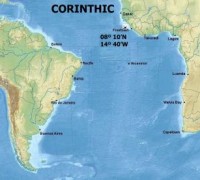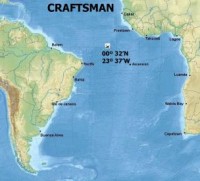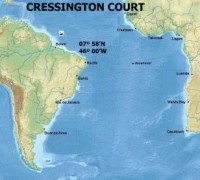- A B C
69)CRITON MoWT (VICHY SLOOP)
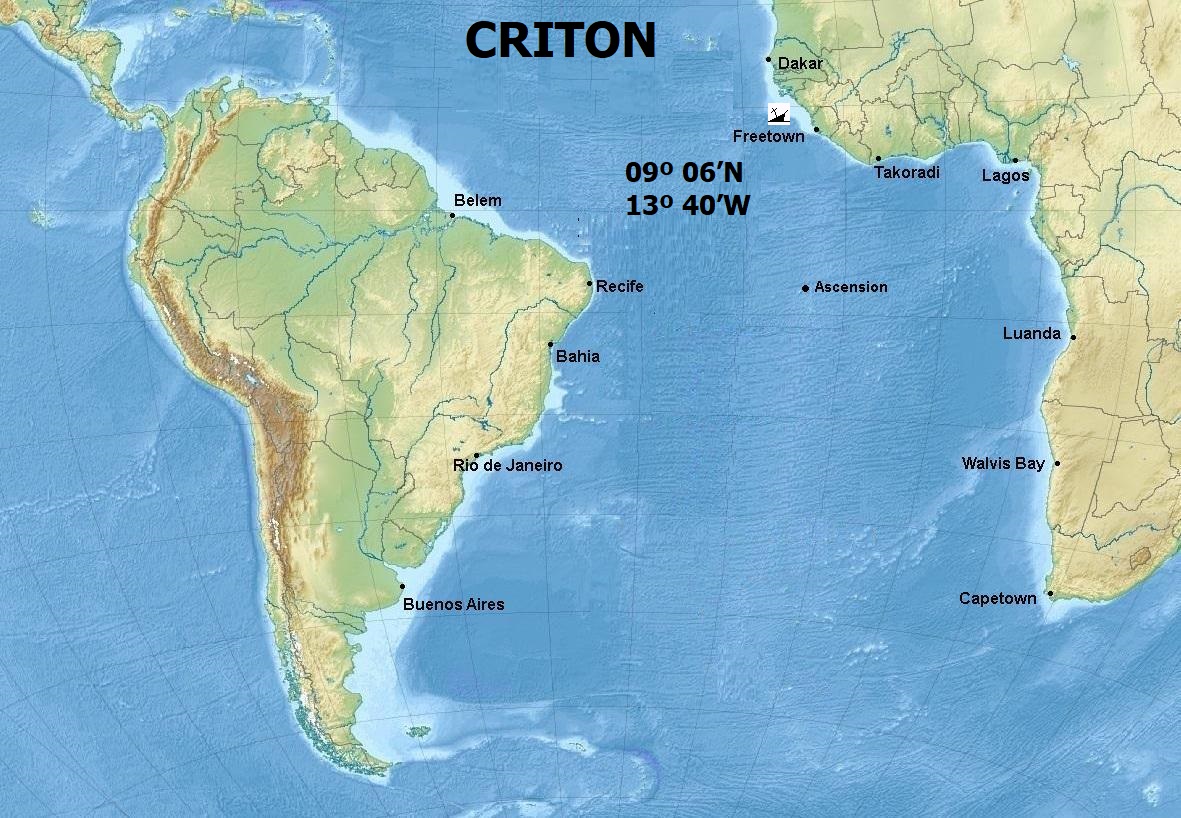
Photo by Peter De Neumann

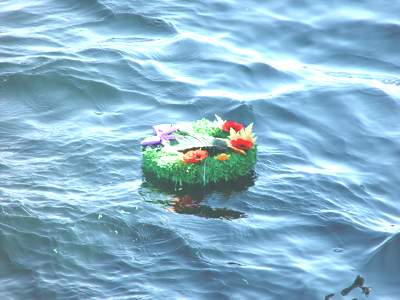
Built 1927
Tonnage: 4,564 / 8,420 tons
Cargo: shells to replenish the garrison shore-batteries at Dakar and 6,000 tons of iron ore
Captured 9 MAY 41 by HMS AMC Cilicia, taken Freetown and put under control of Minister of War Transport.
On 21 JUN 41, stopped (convoy straggler), shelled by Vichy French patrol boat, sunk 09º 06’N 13º 40’W
10 Dead
24 Survivors
At 0930 GMT on the morning of the 21st June 1941, the CRITON spotted two unflagged warships approaching them from the direction of Conakry. One of these vessels ( EDITH GERMAINE ) went out to sea, and cut off any escape route. The other ( AIR FRANCE 4 ) ordered the CRITON to stop, whilst approaching from the port quarter. The CRITON immediately transmitted a radio message saying that they were about to be attacked. With this the AIR FRANCE 4 fired a shot at the CRITON , either at the radio room, or across the bows, and once more ordered the CRITON to stop. Immediately after the shot both warships raised French Ensigns. The CRITON then slowed, as it then appeared better to try and bluff it out rather than continue to attempt to escape.
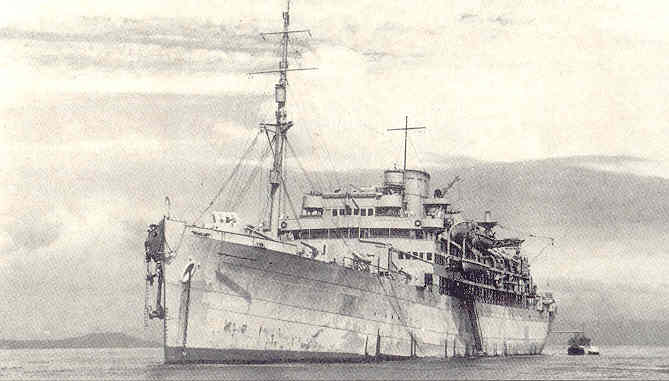
HMS CILICIA in the perspective. Photo Laurence Dunn Collection www.iancoombe.tripod.com
The AIR FRANCE 4 then signalled the CRITON demanding to have identification. The CRITON played for time, whilst the ship's international signal letters group was discovered, of course, the hope was that aircraft or a British warship would be sent to assist. The AIR FRANCE 4 came up alongside the CRITON, lay off about 50 yards and threatened the CRITON with its machine guns.
In response to this threat the CRITON was forced into displaying, or maybe attempted a bluff by displaying, a set of flags which were obtained from the Flag locker, and which probably were the signal letters of the ship. For the CRITON these would have comprised the letter F (for France) followed by three other letters (identifying the ship).
The AIR FRANCE 4 then ordered the CRITON to "Turnabout" and proceed into Conakry. CRITON replied telling AIR FRANCE 4 to "Go to Hell", and held her course. This verbal confrontation took place with the use of old fashioned megaphones! At this time (noon) two and a half hours had elapsed since CRITON first sighted the warships, and, no doubt, the French realised the danger which they might be in, and this coupled with the strange behaviour of the CRITON made the Captain of the AIR FRANCE 4 rather jumpy.
Losing patience the AIR FRANCE 4 came to within 30 yards of the CRITON , and opened up with her machine guns. The Captain of the CRITON ordered "Full Speed Ahead", and whilst the CRITON gathered speed, the AIR FRANCE 4 began shelling the CRITON with her 75mm gun. Several members of the crew of the CRITON were injured during this event. Immediately the shelling commenced the Captain of the CRITON ordered "Stop Engines" and "Abandon Ship".
The AIR FRANCE 4 fired some forty-five 75mm rounds at the CRITON , hitting her superstructure, but especially firing at her water line. Since the cargo was iron-ore which is very dense, the holds were mainly empty, even with a full load, and hence the shells which hit the hull went right through. Some shells narrowly missing de Neumann's boat, which was being launched on the far-side (and therefore invisible from AIR FRANCE 4 ). Captain Dobeson was the last to leave CRITON , but fell into de Neumann's boat and badly injured himself.
After some time in the boats, and when the CRITON was adjudged to be thoroughly disabled, the survivors were picked up by AIR FRANCE 4 and taken into Conakry. At Conakry they were disembarked into a banana shed on one of the wharves and kept under guard for several hours until the police arrived. The men were then taken to a concentration camp in the jungle, about four miles outside of Conakry, where they were forced with bayonets and rifle butts into a specially prepared and wired off compound in a camp that was already occupied by Europeans.
CRITON' s crew later learned that these other occupants were merchant seamen from sunken Allied merchant ships who had made landfall from their lifeboats on Vichy territory. However CRITON' s crew, and especially her executive officers were singled out for special treatment and kept isolated from the others with the threat that anyone who tried to talk through the wire would be shot. CRITON 's crew were individually interrogated by the French Colonial Police, whom CRITON 's crew regarded as effectively Gestapo.
Quite quickly the French Naval Authorities had realised that, embarrassingly, they had sunk their own ship, and thus during the first weeks of their internment in "Sept Kilometres" camp, Conakry, these authorities attempted to blackmail the Officers (by suggesting it would be in their interests), to sign a statement saying that the CRITON had been scuttled.
This the Captain and Officers steadfastly refused to do, and so the (Vichy) French Navy court-martialled the executive officers, charging them with piracy and acting as frank-tireurs. They were all found guilty, and, no doubt remembering Captain Fryatt, who was shot by the Germans as a frank-tireur in the First World War, wondered what their fate would be. This accusation was based on a technicality: the fact that the CRITON had displayed her French registration in answering the call for identification.
The Vichy French Naval Authorities appeared to be desperate to blame the crew of the CRITON for the events which led to its sinking, presumably because they sank their own ship. The treatment of the survivors was uniformly bad, and they were kept isolated from other allied internees. In fact it was made clear that the crew of the CRITON were to receive special treatment.
On September 26, 1941, the whole crew, except those in hospital in Conakry, were ordered out of the camp and into trucks. With a heavily armed guard they were escorted into the jungle, and they started to think that they were to be shot, but it turned out that they were being taken to Conakry railway station. Here they were put on board a train, and a journey began to an unknown destination that lasted until October 7, 1941, when they arrived, they discovered in the legendary city of Timbuctoo.
Conditions in Conakry had been awful, but conditions in Timbuctoo were even worse. They remained in Timbuctoo, being kept under really poor conditions until August 5, 1942, when they were once more embarked upon a journey with unknown destination. On August 24, 1942, they arrived at a camp set up in an agricultural college just outside Kankan.
Here they remained until December 14, 1942, when they began their journey of repatriation, arriving at Freetown on December 18, 1942. From Freetown they sailed back to the Clyde arriving on January 15, 1943. Peter de Neumann attended his investiture at Buckingham Palace on February 11th 1943, the story appeared in the national press the next day under the headline "The Man From Timbuctoo" (a title that stuck to him for the rest of his life), and he was married on February 13, 1943. After some survivors leave, he returned to sea.
The crew of the CRITON received far worse treatment than any other British prisoners of the Vichy French, and were imprisoned longer than other prisoners in West Africa. After the war the French government made an ex gratia payment to the British government in compensation, but did not apologise. To add insult to injury, the British Labour government of the day kept the money, and the exceedingly poor treatment of the crew of the CRITON conveniently forgotten. Like the Japanese, the Vichy French withheld medicines, Red Cross parcels, clothing and footwear, leaving them rotting in the sun.
Captain Gerald Dobeson, CRITON 's Master, received a King's Commendation for Brave Conduct in June 1943.
CRITON crew who died:
William Freeman - 19 November 1942.
Douglas Hyland - 16 January 1943.
Jack Savage - 10 September 1941.
William T. Williams (Striker) - 20 August 1942.
The following two from ALLENDE died and are buried in Timbuctoo. They were briefly imprisoned with CRITON 's crew following ALLENDE 's loss on 17 March 1942:
John Graham - 2 May 1942. Allende
William Soutter - 28 May 1942. Allende
Ref. used:
[1] Daily Express "The Man From Timbuctoo" 10 February 1943
[2] Records Of French Naval Authorities At Conakry
[3] Reminiscences Of Peter De Neumann

